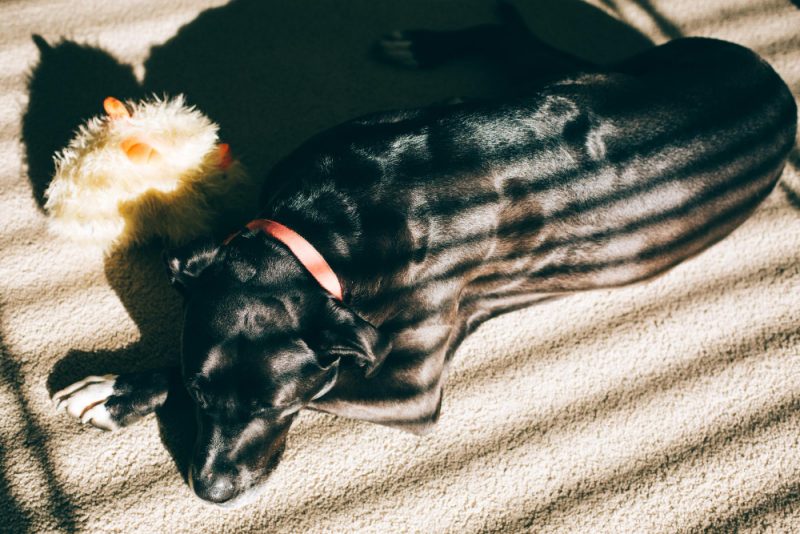
- Home
- Dog Behaviour
- Why Do Dogs Love to Sunbathe – Especially After a Snack?
Why Do Dogs Love to Sunbathe – Especially After a Snack?

It’s a common sight for many dog guardians: your pup finishes their meal, gives a satisfied stretch, and heads straight for a sunny spot to soak up the rays. Whether it’s a nap in the backyard or sprawling across a patch of sunlight on the lounge room floor, dogs seem to absolutely love sunbathing—particularly after they’ve eaten.
But what’s behind this adorable behaviour? At Jordan Dog Training, we believe that understanding our dogs’ habits helps build a stronger bond and supports their overall wellbeing. Let’s explore why so many dogs are drawn to the warmth of the sun, especially after a snack.
1. The Warmth Feels Good and Aids Digestion
After a meal, your dog’s body works to digest the food, and a warm, sunny spot can help them feel more comfortable during that process. Just like humans might enjoy a post-lunch lie-down, dogs instinctively seek out warmth to relax. Sunlight can also help promote blood circulation, which may support the digestive process and help your dog settle into a state of rest and recovery.
2. Temperature Regulation and Energy Conservation
Dogs often use external heat sources to help regulate their body temperature. Lying in the sun allows them to warm up without expending energy, which is especially beneficial in the cooler months or for dogs with leaner builds or short coats.
This is a natural, energy-efficient way for them to stay comfortable—just like a lizard warming up on a rock.
3. Sunlight Boosts Mood and Mental Wellbeing
Sunlight helps regulate the production of serotonin, often called the “feel-good” hormone. Increased serotonin can promote a sense of calm, relaxation, and happiness in dogs. Some studies also suggest that natural light helps regulate a dog’s circadian rhythm, which supports better sleep patterns and overall behavioural stability.
If your dog seems calmer and more content after some time in the sun, it might not be your imagination!
4. Sunlight May Provide Mild Pain Relief
For dogs with arthritis or stiff joints, sunbathing can provide soothing relief. The gentle warmth can act like a natural heat pack, helping to ease muscular tension and joint discomfort. This is particularly helpful for senior dogs or breeds prone to joint issues, though dogs of all ages seem to enjoy the effect.
5. Skin and Coat Health
Sun exposure can play a small role in maintaining skin health. The sun’s ultraviolet rays have mild antibacterial properties, which may help reduce skin bacteria and aid in keeping the coat clean. Additionally, sunlight encourages the production of natural oils that keep the coat soft and glossy.
Of course, balance is important—too much sun can dry out the skin or cause burns in sensitive areas.
6. Vitamin D Synthesis – But It’s a Bit Different for Dogs
Unlike humans, dogs don’t absorb much Vitamin D through their skin. Instead, the oils on their coat produce Vitamin D when exposed to sunlight. When dogs lick and groom themselves, they ingest these oils, giving them a small boost of the vitamin. It’s not their primary source (diet plays a bigger role), but it’s still a fascinating aspect of their behaviour.
7. Natural Instinct and Routine
Many dogs simply develop a routine of heading to a sunny spot after meals—it becomes part of their daily rhythm. This behaviour is often reinforced over time because it feels good and provides a sense of safety and comfort. For dogs that were bred for working outdoors, seeking out warmth is an instinctive behaviour that ties back to their ancestry.
8. Sunlight May Help Deter Parasites
Some research suggests that exposure to direct sunlight can help reduce the risk of certain parasites like fleas, which thrive in dark, humid environments. While it’s no replacement for proper parasite prevention, sunbathing may contribute in a small way to keeping your dog comfortable.
Safety Tips: Let Them Sunbathe, But Watch for Signs of Overheating
While sunbathing can be beneficial, it’s important to ensure your dog stays safe—especially in the Australian climate.
- Always provide access to shade and fresh water
- Avoid prolonged exposure during peak heat (typically 11am–3pm)
- Watch for signs of overheating: excessive panting, drooling, restlessness, or lethargy
- Consider pet-safe sunscreen for light-coloured dogs or those with thin coats, especially around the nose and ears
- Use cool mats or fans indoors if your dog seeks warmth but it’s too hot outside
Final Thoughts
A dog lying happily in the sun after a snack is a picture of peace—and it turns out there’s quite a bit of science and instinct behind it. Whether it’s for warmth, relaxation, or just because it feels good, sunbathing is a natural behaviour for many dogs. As long as they’re doing it safely, there’s no reason not to let them enjoy it.
Understanding your dog’s little quirks and routines is part of what makes life with them so rewarding. At Jordan Dog Training, we’re here to help you build a deeper connection with your dog—through positive training, thoughtful care, and a little curiosity about why they do the things they do.
Disclaimer:
This article is intended as general guidance only and is based on current understanding of dog behaviour and welfare. It is not veterinary advice. We are not veterinarians, and this information should not be used to diagnose or treat any health condition in your pet. If you are concerned about your dog’s health, behaviour, or sun exposure, we strongly recommend speaking with your veterinarian. Every dog is different, and professional advice tailored to your dog’s individual needs is always best.

Justin Jordan
Master Trainer
- In-home behaviour modification consultations
- Puppy schools
- Obedience classes
- Specialist training
- Media enquiries
- Trainer opportunities
- Supplier enquiries
- Guest appearances
















